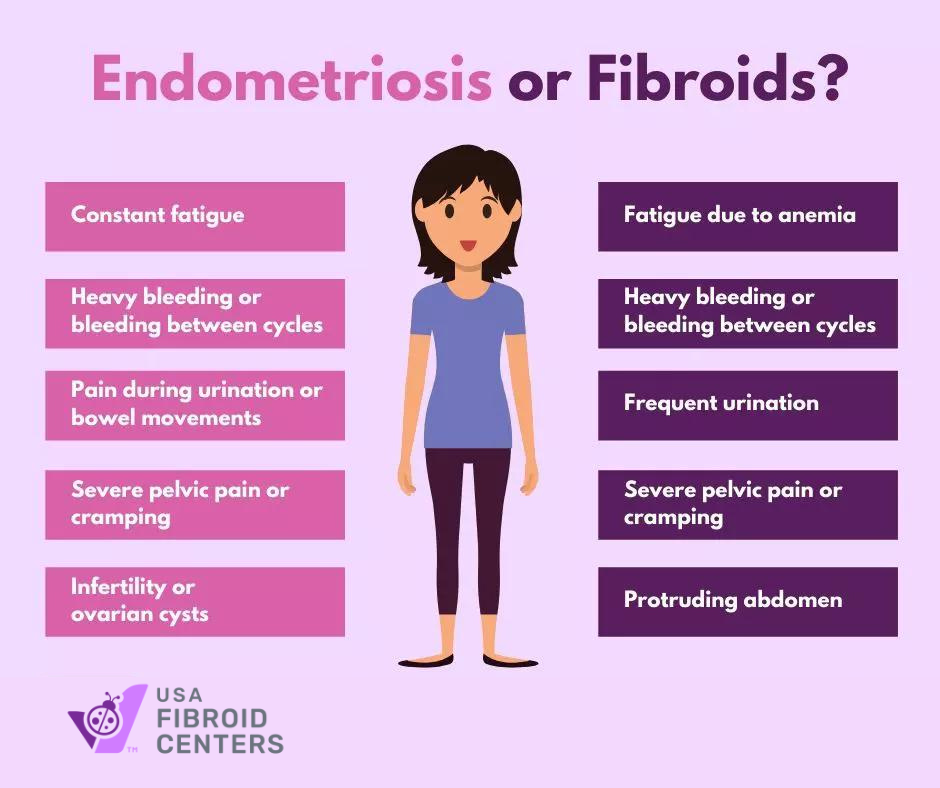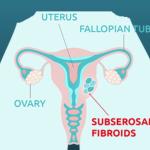
Topics Covered in this blog
- Uterine Fibroids vs. Endometriosis
- Endometriosis vs. Fibroid Symptoms
- Fibroids or Endometriosis While Pregnant
- What is the Difference Between Diagnosing Fibroids and Endometriosis?
- Fibroids and Endometriosis Treatment
- Visit USA Fibroid Centers for Diagnosis and Treatment
Pelvic pain got you stumped?
While both fibroids and endometriosis can affect your well-being, they’re distinct conditions. Understanding the differences between these two common female health challenges can help you explain your symptoms effectively and discuss with your doctor to find the right path to relief.
If you are suffering from pelvic pain, then either endometriosis or fibroids may be the cause. However, you won’t know for sure until you receive a diagnosis, which involves pelvic exam and an imaging test such as an ultrasound.
Understanding the difference between fibroids and endometriosis is important to better understand your health, explain your symptoms to your physician, and pursue a treatment plan that will alleviate any symptoms.
Uterine Fibroids vs. Endometriosis
Both uterine fibroids and endometriosis are noncancerous gynecological conditions, but they develop in distinct ways.
Fibroids are benign tissue tumors that grow from the uterine wall. There are a few different types of fibroids, classified by their location, and they can grow in clusters of multiple fibroids or large enough to cause visible swelling in the abdomen.
With endometriosis, the inner lining of the uterus (called the endometrium) begins to grow outside of the uterus. This can be a painful and chronic medical condition where the overgrowth of tissue can also affect the ovaries, fallopian tubes, and pelvic tissue.
Request a Consultation With a Fibroid Specialist
Endometriosis vs. Fibroid Symptoms
Women with endometriosis or uterine fibroids experience symptoms that range from uncomfortable to life-disrupting. Although both conditions share some symptoms, there are also key differences to be aware of:
Fibroids
- Heavy or prolonged menstrual periods
- Abnormal bleeding between periods
- Frequent urination
- Pelvic pain or pressure
- Pain during sexual intercourse
- Constipation and bloating
Endometriosis
- Pain before and during periods
- Fatigue
- Painful urination and/or bowel movements during periods
- Painful sexual intercourse
- Digestive issues and abdominal pain
In addition, both uterine fibroids and endometriosis may lead to an increased risk of difficulty with fertility or pregnancy. Take our quick quiz to learn if fibroids are causing your symptoms.
Fibroids or Endometriosis While Pregnant
Both fibroids and endometriosis can make it difficult to conceive, but it is possible to become pregnant with either condition. Some women have no symptoms or issues during their pregnancy, while others may experience complications.
If fibroids continue to grow during a woman’s pregnancy, they can take up space needed for the baby’s growth. They may also make normal delivery difficult, requiring a Cesarean section delivery.
Endometriosis can also cause complications with pregnancy, including an increased risk of miscarriage and preeclampsia. If you become pregnant while you have either fibroids or endometriosis, your doctor will likely want to keep a close eye on your health.
What is the Difference Between Diagnosing Fibroids and Endometriosis?
Fibroids and endometriosis may have a preliminary diagnosis with a pelvic exam at a doctor’s visit. The doctor may diagnose fibroids after hearing about a patient’s symptoms and conducting a pelvic examination. They may also recommend an MRI or ultrasound to get a better understand of your fibroids, helping inform how many there are and where they are located.
Women at Risk of Fibroids and Endometriosis
-
Uterine fibroids: These frequently affect women of childbearing age, particularly those between 35 and 49. African American women and those with a family history of fibroids have a higher risk.
-
Endometriosis: This condition can impact women of all ages but is often diagnosed during the teenage years and young adulthood.
Fibroids and Endometriosis Treatment
Both fibroids and endometriosis have various treatment approaches depending on the individual’s specific situation, including the severity of symptoms, age, and desire for future pregnancy.
Consulting with a healthcare professional to discuss the appropriate treatment plan is crucial. It’s important to note that additional treatment may be necessary if other medical conditions are present alongside either fibroids or endometriosis.
Uterine Fibroid Treatment
Many women facing uterine fibroids are often presented with two surgical options: a hysterectomy, which removes the entire uterus, or a myomectomy, which targets and removes the fibroids themselves. However, a less invasive alternative is Uterine Fibroid Embolization (UFE).
During UFE, a specialist blocks the blood supply to the fibroids, causing them to shrink and die. This often leads to a significant reduction or complete resolution of symptoms. Benefits of UFE include:
- Minimally invasive: No large incisions are required.
- Faster recovery: Compared to traditional surgery.
- Preserves the uterus: A crucial factor for women who may wish to have children in the future.
Endometriosis Treatment
Laparoscopic surgery may be recommended to improve fertility, manage pain, or remove endometriosis tissue. Over-the-counter pain relievers can help manage discomfort. Hormone therapy can help slow the growth of the endometrial tissue but is not suitable for everyone.
Visit USA Fibroid Centers for Treatment
USA Fibroid Centers specializes in FDA-approved uterine fibroid embolization (UFE). If you are suffering from painful and prolonged menstruation that continues for more than a week, pelvic pain and pressure, frequent urination, pain during sexual intercourse, constipation, or bloating, UFE can effectively relieve these symptoms.
Treatment at USA Fibroid Centers is covered by most insurance plans. If fibroids or pelvic pain is causing uncomfortable or painful symptoms, the specialists at USA Fibroid Centers are here to help. Schedule a consultation today or call us at 855.615.2555.
Sources:
- UT Southwestern Medical Clinic. (June 2019) Fertility-sparing treatment for endometriosis and fibroids.
- Frontiers. (October 2021) Endometriosis and uterine fibroids: Comorbidity, Risks, and Implications.
Medical News Today (May 2022). What to Know About Endometriosis during Pregnancy.




